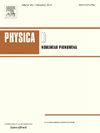Fractured alliances in a four-species cyclic ecological system
IF 2.7
3区 数学
Q1 MATHEMATICS, APPLIED
引用次数: 0
Abstract
We consider two Lotka–Volterra type models for ecological communities exhibiting a modified form of cyclic competition. The first governs a four-species ecological system. When each species competes only with one other species cyclically, then, it is known that, for strong competition the system evolves to one of two alliances of non-competing species.
We consider the case when there is internal competition and predation within one of the alliances. This leads to an embedded three-species rock–paper–scissors () community, which can be dynamically unstable — leading to attracting heteroclinic cycles within the four-species system. We show that, even for vanishingly small fracturing, other outcomes are also possible. We identify all possible physical steady states, their stabilities and bifurcations which can occur between them (eight bifurcations in all).
For our second model, we consider the case of two ecological communities within a heterogeneous environment. The communities are coupled, allowing information exchange between them. We prove that for strong coupling the two communities will form a unified state corresponding to one with averaged ecological parameters. For the case of dynamically unstable communities (i.e., heteroclinic cycles), we develop a method to characterize the averaged heteroclinic cycle based on the rate of expansion of trajectory visits to the appropriate saddle. Information exchange can allow small ecological heterogeneities to lead to very major changes in the steady state. In particular, information exchange can quench heteroclinic cycles within both communities or conversely can allow for heteroclinic cycles where none would occur for each community in isolation.
求助全文
约1分钟内获得全文
求助全文
来源期刊

Physica D: Nonlinear Phenomena
物理-物理:数学物理
CiteScore
7.30
自引率
7.50%
发文量
213
审稿时长
65 days
期刊介绍:
Physica D (Nonlinear Phenomena) publishes research and review articles reporting on experimental and theoretical works, techniques and ideas that advance the understanding of nonlinear phenomena. Topics encompass wave motion in physical, chemical and biological systems; physical or biological phenomena governed by nonlinear field equations, including hydrodynamics and turbulence; pattern formation and cooperative phenomena; instability, bifurcations, chaos, and space-time disorder; integrable/Hamiltonian systems; asymptotic analysis and, more generally, mathematical methods for nonlinear systems.
 求助内容:
求助内容: 应助结果提醒方式:
应助结果提醒方式:


